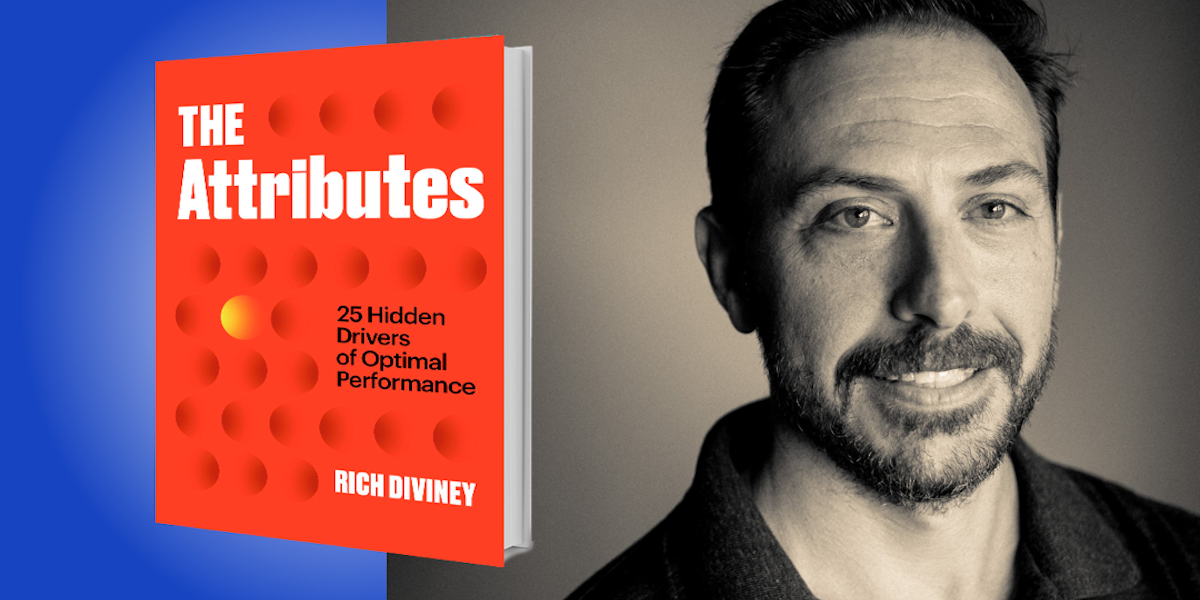Rich Diviney is a retired SEAL commander, who spent more than 20 years in the Navy, including 13 overseas deployments. He led training programs for aspiring SEALs and was charged with developing methods for identifying the Navy’s most elite performers. Since his retirement, Rich has worked as a speaker and consultant with Simon Sinek Inc. and the Chapman & Co. Leadership Institute, teaching leadership skills and optimal performance strategies to major U.S. companies and athletic organizations.
Below, Rich shares 5 key insights from his new book, The Attributes: 25 Hidden Drivers of Optimal Performance (available now on Amazon). Download the Next Big Idea App to enjoy more audio “Book Bites,” plus Ideas of the Day, ad-free podcast episodes, and more.
1. In difficult times, attributes are more important than skills.
Skills are not inherent to our nature. We’re not born with the ability to throw a ball, or ride a bike, or drive a car. We learn these things, and therefore, they’re very easy to see, assess, measure, and test. But attributes—like adaptability, resilience, and self-efficacy—are innate traits that inform how we will acquire skills, how we’ll learn to ride a bike, for example, even after falling off a dozen times. Because they’re in the background, though, attributes are very hard to see, assess, and measure, and appear most visibly only in times of challenge, uncertainty, and stress.
In times of uncertainty, it’s difficult, if not impossible, to apply our acquired skills. Instead, we’re forced to lean on our attributes. We all experienced this in 2020 when a global pandemic threw us into an unprecedented situation in which very few of us had skills we could immediately apply. So we all started leaning on our attributes, things like open-mindedness, humility, patience, and adaptability. To assess someone’s performance, in work and in life, we need to look at that person’s skills and their attributes.
2. Strive for optimal performance, not peak performance.
I realized during my time in the military that Navy SEALs weren’t peak performers. We were optimal performers. A peak is simply an apex from which we can only come down. A peak has to be prepared for, planned, and scheduled. The professional football player, for example, designs his entire week so that he can peak for three hours on Sunday. In real life, though, optimal performance requires us to ask, “How can I do the very best that I can in the moment with whatever I have?”
“In times of uncertainty, it’s difficult, if not impossible, to apply our acquired skills. Instead, we’re forced to lean on our attributes.”
Sometimes our very best might look like a peak. It might look like flow states in which everything is clicking all at once. But sometimes it might look like just taking one step at a time. Sometimes we just have to trudge through and keep moving forward. That is also optimal performance; that is also doing our best.
3. Attributes for optimal performance can be developed.
We all possess the attributes needed for optimal performance, though some of us display these attributes more distinctly than others. I may have a higher level of adaptability than my friend, while he may have a higher level of open-mindedness than me.
But we can develop the attributes we want. We can’t learn them the same way we learn skills; we can’t take a class on how to be more patient or more resilient. Developing an attribute requires self-motivation, self-direction, and a conscious effort to throw oneself into discomfort and uncertainty. If someone wants to develop patience, for example, they have to be willing to throw themselves into situations and environments that test their patience and allow them to consciously develop it.
“Developing an attribute requires self-motivation, self-direction, and a conscious effort to throw oneself into discomfort and uncertainty.”
4. The 5 kinds of attributes for optimal performance.
In my book, I’ve broken the attributes of optimal performance into five different categories, and I describe the attributes that make up those categories. Though not prescriptive, this categorization helps individuals, leaders, and teams assess their strengths and weaknesses. The categories are:
- Grit: courage, perseverance, adaptability, and resilience.
- Mental acuity: situational awareness, compartmentalization, task-switching, and learnability.
- Drive: self-efficacy, discipline, open-mindedness, cunning, and narcissism (even seemingly negative attributes, if maintained at healthy levels, can be extremely powerful drivers of performance and success).
- Leadership: empathy, selflessness, authenticity, decisiveness, and accountability.
- Team ability: integrity, conscientiousness, humility, and humor.
“To set up a truly high-performing team, you need to look at the team members’ attributes.”
5. How to assemble high-performing teams.
Executives I’ve coached have often wondered why the supremely talented teams they’ve put together have failed. I hear things like, “Hey, I put together this dream team of people—the best graphics designer, the best marketing person, the best salesperson. But when things didn’t go as planned, the team turned toxic. Why is that?”
The reason is because we often assemble teams based on skills. And while the team’s skills may tell you how they’ll perform in good times, they don’t tell you how they’ll behave in uncertainty and discomfort, which are bound to occur. To set up a truly high-performing team, you need to look at the team members’ attributes instead, and strive for a diversity of attributes needed for the task at hand.
Often, a key concept for such teams is “dynamic subordination.” In dynamic subordination, when things take a turn for the worse, the person who is the closest to that problem and the most competent to handle it immediately steps up and takes the lead. Everybody else follows. This dynamic swap between leader and follower allows high-performing teams to operate.
For more Book Bites, download the Next Big Idea App today:































